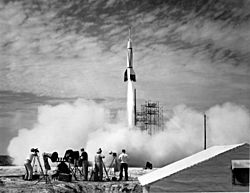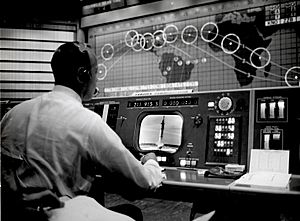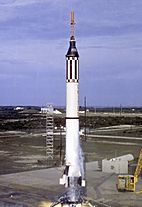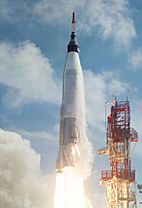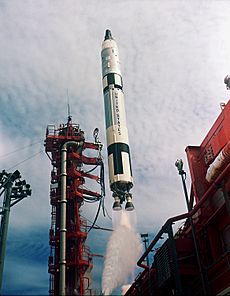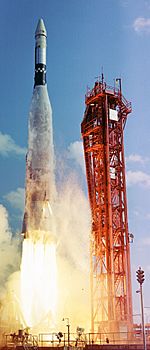Cape Canaveral Space Force Station facts for kids
Quick facts for kids Cape Canaveral Space Force Station |
|||||||
|---|---|---|---|---|---|---|---|
| Part of Patrick Space Force Base | |||||||
| Near Cocoa Beach, Florida in the United States | |||||||

Emblem of Space Launch Delta 45
|
|||||||
|
Location in the United States
|
|||||||
| Coordinates | 28°29′20″N 80°34′40″W / 28.48889°N 80.57778°W | ||||||
| Type | U.S. Space Force Station | ||||||
| Area | 1,325 acres (5 km2) | ||||||
| Site information | |||||||
| Owner | Department of Defense | ||||||
| Operator | United States Space Force | ||||||
| Controlled by | Space Launch Delta 45 | ||||||
| Condition | Operational | ||||||
| Site history | |||||||
| Built | 1949 (as the Joint Long Range Proving Ground) | ||||||
| In use | 1949 – present | ||||||
| Garrison information | |||||||
| Garrison | Space Launch Delta 45 | ||||||
| Airfield information | |||||||
| Identifiers | ICAO: KXMR, FAA LID: XMR | ||||||
| Elevation | 3 metres (10 ft) AMSL | ||||||
|
|||||||
Cape Canaveral Space Force Station (CCSFS) is a special place in Florida, USA. It's where many rockets and spacecraft have been launched into space! This station is part of the United States Space Force. It is located on Cape Canaveral in Brevard County.
The station is near Patrick Space Force Base. It's the main launch site for the Space Force's Eastern Range. It has three active launch pads: SLC-37B, SLC-40, and SLC-41. This facility is south of NASA's Kennedy Space Center. Bridges connect the two sites. Cape Canaveral Space Force Station also has a long runway called the Skid Strip. This runway is used by military planes to bring large equipment to the launch sites.
Many important space missions started here, including:
- The first U.S. Earth satellite, Explorer 1 (1958).
- The first U.S. astronaut in space (1961).
- The first U.S. astronaut to orbit Earth (1962).
- The first U.S. two-person spacecraft (1965).
- The first U.S. uncrewed lunar landing (1966).
- The first U.S. three-person spacecraft (1968).
It was also the launch site for the first spacecraft to fly past every planet in our Solar System (1962–1977). Other firsts include the first spacecraft to orbit Mars (1971) and roam its surface (1996). The first American spacecraft to orbit and land on Venus (1978) also launched from here. Later, the first spacecraft to orbit Saturn (2004) and Mercury (2011) took off from Cape Canaveral. Finally, Voyager 1, the first spacecraft to leave our Solar System (1977), began its journey here.
Some parts of the base are now a National Historic Landmark. This is because of their important role in the early days of the American space program.
Over the years, Cape Canaveral has had different names:
- Cape Canaveral Launch Area (1949)
- LRPG Launching Area (1950)
- Cape Canaveral Auxiliary Air Force Base (1951–1955)
- Cape Canaveral Missile Test Annex (1955–1964)
- Cape Kennedy Air Force Station (1964–1974)
- Cape Canaveral Air Force Station (1974–1994 and 2000–2020)
- Cape Canaveral Air Station (1994–2000)
- Cape Canaveral Space Force Station (December 2020–present)
Contents
History of Space Launches
The U.S. government started testing missiles at Cape Canaveral in 1949. President Harry S. Truman created the Joint Long Range Proving Ground here. This spot was perfect for launches because rockets could fly over the Atlantic Ocean. It's also close to the equator, which gives rockets an extra push from Earth's spin.
Early Air Force Testing
In 1948, the U.S. Navy gave the Banana River Naval Air Station to the United States Air Force. It was renamed the Joint Long Range Proving Ground (JLRPG) Base. In 1950, it became Patrick Air Force Base. The Air Force also set up the Air Force Missile Test Center in 1951.
Early American rocket flights happened here in 1956. After the Soviet Union launched Sputnik 1 in 1957, the U.S. tried to launch its first satellite from Cape Canaveral. But the rocket, Vanguard TV3, exploded on the launch pad in December 1957.
NASA was created in 1958. Air Force teams helped NASA launch missiles from the Cape. Many types of missiles were tested here, like Redstone, Jupiter, and Atlas. The Thor rocket became the basis for the Delta rocket. This rocket launched Telstar 1 in 1962, which was an early communications satellite. The launch pads along the coast became known as "Missile Row" in the 1960s.
Project Mercury: First American Astronauts
NASA's first program to send people into space was called Project Mercury. U.S. Air Force teams helped with these launches from Cape Canaveral. The goals of Mercury were to:
- Send a spacecraft with a crew into Earth's orbit.
- See how well humans could work in space.
- Safely bring the astronaut and spacecraft back to Earth.
Short "suborbital" flights used Redstone rockets from Launch Complex 5 (LC-5). Alan Shepard was the first American in space on May 5, 1961. Gus Grissom followed on July 21. Longer "orbital" flights used bigger Atlas D rockets from Launch Complex 14 (LC-14). John Glenn was the first American to orbit Earth on February 20, 1962. Three more orbital flights happened until May 1963.
The Mercury Control Center at Canaveral managed all Mercury missions.
Changes in Names
After President John F. Kennedy passed away in 1963, President Lyndon B. Johnson renamed NASA's launch center and the Cape Canaveral missile test site as the "John F. Kennedy Space Center." He also changed the name of Cape Canaveral itself to Cape Kennedy. This caused some confusion, as people thought both places were the same.
NASA clarified that Kennedy Space Center was only for Merritt Island. The Air Force renamed its launch site Cape Kennedy Air Force Station. This name was used during the Project Gemini and early Apollo program.
However, many people did not like the name change for Cape Canaveral. It was a very old name, used since the 1500s. So, in 1973 and 1974, both the geographical name and the Air Force Station name went back to Canaveral.
In 2020, the facility was officially renamed "Cape Canaveral Space Force Station."
Gemini and Early Apollo Missions
The Gemini program used two-person spacecraft. These were launched into orbit by Titan II rockets from Launch Complex 19 (LC-19). Ten of the twelve Gemini flights had crews. The first crewed flight, Gemini 3, was on March 23, 1965. Later Gemini missions practiced meeting and connecting with other spacecraft in orbit. This was important for the Apollo program.
The Apollo program aimed to land humans on the Moon. This needed very powerful Saturn rockets. The huge Saturn V rocket, which took astronauts to the Moon, needed a bigger launch site. So, NASA built the Kennedy Space Center on Merritt Island, next to Cape Canaveral.
However, the smaller Saturn I and Saturn IB rockets could launch from Cape Canaveral's Launch Complexes 34 and 37. The first Saturn I launches happened from LC-34 in 1961-1963. Saturn IB rockets were used for Earth orbit tests of the Apollo spacecraft.
Sadly, on January 27, 1967, the crew of Apollo 1 (Gus Grissom, Ed White, and Roger Chaffee) died in a fire during a test on pad 34. After many safety improvements, Apollo 7 launched from LC-34 on October 11, 1968. This mission successfully tested the Apollo spacecraft in Earth orbit.
In 1972, NASA stopped using LC-34 and LC-37. LC-34's launch tower was removed, leaving only the concrete pad as a memorial. In 2001, LC-37 was reopened and updated to launch Delta IV rockets.
Later Space Activities
The Air Force improved the Titan rockets for lifting heavy payloads. They built Launch Complexes 40 and 41 to launch Titan III and Titan IV rockets. These were just south of Kennedy Space Center. Titan III rockets could carry about the same amount as the Saturn IB, but at a lower cost.
Launch Complexes 40 and 41 have launched many satellites for defense, communication, and weather. They also launched NASA missions to other planets. From 1974 to 1977, the powerful Titan-Centaur rocket launched the Viking and Voyager spacecraft from LC-41.
Today, private companies like SpaceX also use launch pads at Cape Canaveral. This has led to many more launches. SpaceX uses SLC-40 for its Falcon 9 rockets. They also use Launch Complex 39A at Kennedy Space Center for their Falcon Heavy and crewed Crew Dragon missions.
The first U.S. satellite, Explorer 1, was launched on February 1, 1958, from Canaveral's LC-26A. NASA's first launch, Pioneer 1, happened on October 11, 1958, from LC-17A.
During the 1960s, Atlas-Agena launch complexes (LC-12 and LC-13) were used for the uncrewed Ranger and Lunar Orbiter programs. These missions studied the Moon. They also launched the first five Mariner probes to other planets. The Atlas-Centaur launch complex (LC-36) was used for the Surveyor lunar landing program and later Mariner probes.
NASA has also launched communications and weather satellites from LC-40 and LC-41. These were built by the Air Force in 1964. From 1974 to 1977, the powerful Titan IIIE rocket launched the Viking and Voyager missions, and the Cassini–Huygens probe to Saturn, from LC-41.
Today, three launch pads at Cape Canaveral are used by private companies:
- SLC-41 for the Atlas V rocket.
- SLC-37B for the Delta IV rocket. Both are used by United Launch Alliance.
- SLC-40 for SpaceX's Falcon 9 rocket.
Boeing X-37B Spaceplane
The Boeing X-37B is a special uncrewed spacecraft. It can be reused and is operated by the USSF. It's also called the Orbital Test Vehicle (OTV). This spaceplane has been launched successfully four times from Cape Canaveral using Atlas V rockets.
The X-37B missions launched on:
- April 22, 2010
- March 5, 2011
- December 11, 2012
- May 20, 2015
The fourth X-37B mission landed at the Kennedy Space Center on May 7, 2017. It had spent 718 days in orbit! The first three X-37B missions landed on a special runway at Vandenberg Space Force Base in California. This runway was originally built for the Space Shuttle.
Many launch pads built since 1950 are now used by private space companies. For example, Launch Complex SLC-17 was used for the Delta II rocket until 2011. Launch Complexes SLC-37 and SLC-41 were updated to launch Delta IV and Atlas V rockets. These new rockets replaced older Delta, Atlas, and Titan rockets. Launch Complex SLC-47 is used for weather rockets.
SLC-40 was where the first SpaceX Falcon 9 rocket launched in 2010. Falcon 9 rockets continued to launch from here for missions to the International Space Station and for commercial satellites. SpaceX also uses Launch Complex 39A at NASA's Kennedy Space Center. This pad is used for their powerful Falcon Heavy rocket and for sending astronauts to the ISS. SpaceX also has Landing Zone 1 and 2. These are used to land the first stages of their Falcon 9 and Falcon Heavy rockets after launch.
In 2015, NASA announced that Blue Origin will use Launch Complex 36. They will update it to launch their new rockets.
Cape Canaveral is located at 28°27'N latitude. This is a good spot for launching rockets that need to go into orbits that circle the Earth near the equator (like for geostationary satellites). The Earth's spin gives rockets an extra speed boost when launched eastward from here. This boost is about 908 miles per hour (406 m/s). Other launch sites closer to the equator, like the European Guiana Space Centre, get an even bigger boost.
For rockets that need to go into orbits that pass over the Earth's poles, Cape Canaveral is not ideal. This is because populated areas are under those flight paths. Instead, Vandenberg Space Force Base in California or the smaller Pacific Spaceport Complex – Alaska are used for polar launches.
The Air Force Space and Missile Museum is located at LC-26. Hangar AE collects data from launches across the United States. NASA also has data centers there to watch launches in real-time.
The Cape Canaveral Space Force Station Skid Strip (airport code: XMR) is a military airport at CCSFS. It's about 7 miles (11 km) northeast of Cocoa Beach, Florida. It has a long runway, 10,000 feet (3,048 m) long and 200 feet (61 m) wide. The United States Space Force owns this facility.
It was first called the Skid Strip because SM-62 Snark cruise missiles, which didn't have wheels, were supposed to skid to a stop on it after test flights.
In the 1960s, large planes like the Douglas C-133 Cargomaster often visited. They carried parts of Atlas and Titan missiles. These missiles were used as rockets for space programs, including those leading to the Apollo Moon landings. NASA's special transport planes, the Pregnant Guppy and Super Guppy, also used the Skid Strip. They carried the upper stages of the Saturn IB and Saturn V rockets.
Today, the Skid Strip is mainly used by Air Force planes like the C-130 Hercules, C-17 Globemaster III, and C-5 Galaxy. These planes bring satellites and other large equipment to CCSFS for launch.
It's important not to confuse the CCSFS Skid Strip with the NASA Shuttle Landing Facility. That runway was built specifically for the Space Shuttle and is located on Merritt Island at the Kennedy Space Center.
The U.S. Navy's Naval Ordnance Test Unit (NOTU) is also located at Cape Canaveral SFS. NOTU was created in 1950. Its main job was to help develop and support the submarine-launched Fleet Ballistic Missile (FBM) program. This included the Polaris missile and later the Poseidon missile programs.
NOTU's mission is to support and test sea-based weapons systems for the United States Navy and the Royal Navy. They do this safely using the air and water space of the Eastern Range. NOTU helps the U.S. Navy's Trident Submarines and the United Kingdom's Fleet Ballistic Missile program. NOTU also runs the Navy Port at Port Canaveral. This port supports submarines and ships from the U.S. Atlantic Fleet, NATO, and other navies. NOTU has over 100 active U.S. Navy personnel and more than 70 contractors.
Units Based Here
These are some of the military units located at Cape Canaveral Space Force Station:
United States Space Force
- Space Operations Command (SpOC)
- Naval Ordnance Test Unit
Images for kids
-
Cape Canaveral as seen from orbit by a Space Shuttle in 1991
-
Titan III-E launching Voyager 2 probe in 1977 from SLC-41
-
Launch of a set of Orbcomm communications satellites atop a Falcon 9 rocket from SLC-40 in 2015
-
An aerial view of SLC-41 with its crew access tower and arm prior to the first launch of Vulcan Centaur carrying Peregrine Mission One.
See also
 In Spanish: Estación de la Fuerza Espacial de Cabo Cañaveral para niños
In Spanish: Estación de la Fuerza Espacial de Cabo Cañaveral para niños



